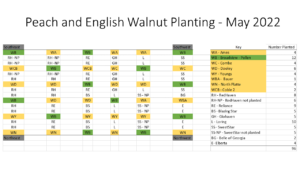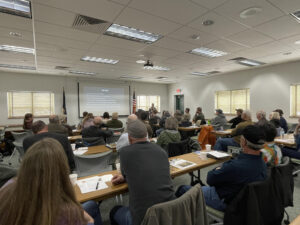Final report for FNC22-1329
Project Information
The Johnson’s are first generation farmers with 5 kids, ages 5-13. Our 180-acre farm, Ox Heights, is in Presque Isle County Michigan (NE lower peninsula), and is certified in the Michigan Agriculture Environmental Assurance Program in Farmstead Systems, Cropping, Livestock, and Forest, Wetlands, and Habitat Systems. With support from SARE (Projects FNC17-1081 and FNC19-1170), USDA Natural Resources Conservation Service, and our kids, we are learning and demonstrating how farmland in the North Central Region can grow sustainable, high value, and diverse crops. We maintain 20 ewes that produce 30-40 lambs for meat annually. For the past 2 years the sheep have been rotationally grazed through our 20 acres of grafted European chestnuts (SARE FNC17-1081 and FNC19-1170). Hay for the winters is taken from about 10 acres. Our remaining acreage is managed for Christmas greenery and hardwood timber. We maintain small plots (less than 3 acres total) of peaches, hazelnut, apple, pear, and grapes that produce annually.
We established a novel intercropping of English walnut, peaches, and livestock and demonstrate this sustainable whole-farm system through NRC-SARE. Integration of diverse, short-term, long-term, high risk, and low risk farm revenue streams is critical for economic viability, environmental stability, and community diversity. However, the transition from monoculture agro-systems to diverse systems is rarely intuitive or initially profitable. Intercropping is a means to diversify but requires compatibility of crops. Many farmers desire to diversify and increase revenue by establishing walnut orchards (English or Black), but decades are required for return on investment and comes with the cost of not producing another crop. Intercropping walnut with other commodities would bridge the financial gulf and provide diversity, but walnut produce a toxic chemical (juglone) which limits traditional intercropping options. Peach offers an attractive option to intercrop between walnuts because they are tolerant of juglone, produce fruit within 2 years, and typically die back by year 15. This scenario also offers an opportunity to establish a forage crop (clover, tolerant of juglone) between the rows of trees. Sheep, given their small size, can graze rotationally on the forage and serve as another revenue source, while controlling weeds and enhancing the soil.
- Establish a novel intercropping of English walnut, peaches, and livestock.
- Disseminate the design, costs, production, and acreage saved in the agroforestry system through a blog, social media, field day, final report to SARE, and conference presentation.
Cooperators
- - Technical Advisor
- - Technical Advisor
Research
Orchard Establishment:
An intercropped orchard of English Walnuts and Peaches was established on 1.25 acres of land within a fenced pastureland during April-May 2022. Thirty-seven grafted English walnuts were planted at 40 ft spacing in a 6 x 6 grid according to guidelines published by the New York Nut Growers Association (NYNGA) and Grimo Nursery (with irrigation, weed control mats, tree tube). Specifically, 7 grafted walnut cultivars with a history of success growing in Ontario and New York (Zone 6a) were planted and these are the same exact cultivars currently being tested by NYNGA; therefore, our data will complement their ongoing field trials. Broadview is the primary pollen producing cultivar. During the 2022 and 2023 growing seasons (May - October), walnuts were grown in tree tubes (5 ft) supported by conduit (10 ft long, 1/2 inch diameter). Root suckers were removed throughout the season to ensure growth was occurring on grafted wood.
Peaches (n=59) were planted within the rows English Walnuts and tolerate the juglone produced by the walnut. They were spaced 13 feet from other walnuts and peaches. Eight varieties were planted with the goal of elongating the harvest season with each variety maturing at different times and included Red Haven, Reliance, Blazing Star, Glohaven, Loring, and Sweet Star with a Lowell rootstock. Due to shortages in nursery stock during 2022, 6 Risingstar and 5 Glowingstar were not planted as planned in 2022, but space was allocated for them in the orchard and they were planted in spring 2023. Since only one year of growth data were collected on the Risingstart and Glowingstar that were planned in 2023, those data are not reported together with growth data on the trees planted in 2022. The rootstock and these varieties are adapted to the Michigan climate, are recommended by Michigan State University, and were planted according to their guidelines. The life expectancy of a peach orchard is 10-20 years, which is when the walnuts will become the dominate tree in the orchard.
For both walnut and peaches, planting holes were amended with 5 gallons of composted sheep manure and 1 gallon of lime. In October of each year, mouse guards were placed on the trunks and the trunks of each tree was painted white to prevent southwest disease (sunscald). Irrigation was available to all trees using 1 gallon/per hour emitters. About 3 gallons of water per tree was administered about 2 times per week during weeks when rainfall was less than 0.5 inch.
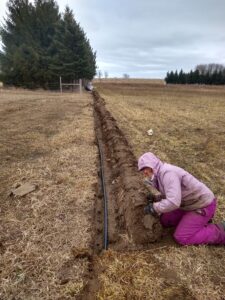
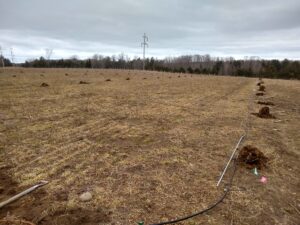

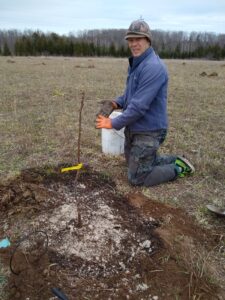
Forage Production and Rotational Grazing
Forage was harvested and sheep were rotationally grazed in the aisles of the orchard. Red clover was frost seeded in the orchard in April 2022 to diversify forage and fix nitrogen. Inorganic potassium at a rate of 50/lbs per acre was applied to the field during April 2023. In each year, the first cutting of hay was harvested from the aisles in May or June and sheep were rotationally grazed through the orchard for 2nd (August) and 3rd cutting (October). Grazing practices were implemented according to those outlined by USDA Environmental Quality Incentive Program. Because the orchard was located within a robust perimeter fence, temporary fence was used to direct grazing in specific areas. Livestock water was available through the orchard because of the irrigation present.
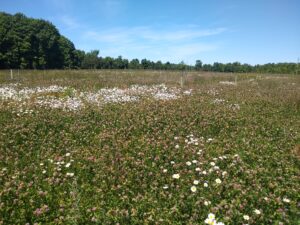
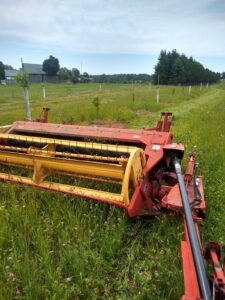
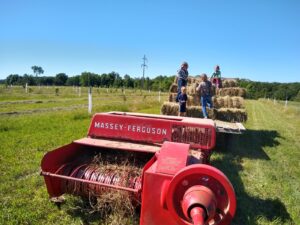
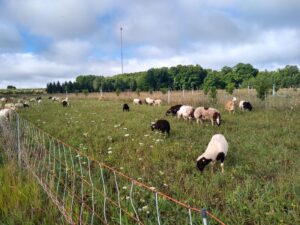
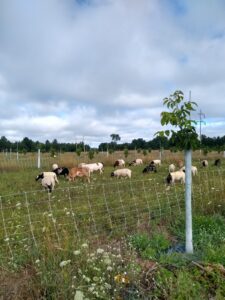
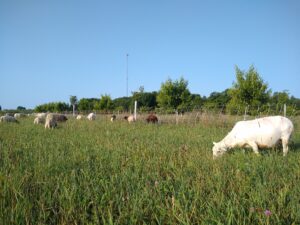
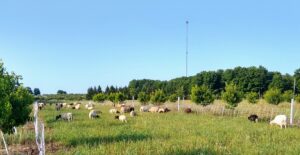
Documenting Changes in Soil Heath
To evaluate if the pasturing of sheep in the intercropped walnut and peach orchard increases soil health, we collected 5 soil samples in April 2022 in the aisles of the orchard and again at the conclusion of our project in October 2023. Soil samples were collected to a depth of eight inches. Samples were submitted to Ward Laboratories for complete nutrient analysis, and for active carbon (POXC) analysis, like in our previously funded work.
Survival and growth of walnuts and peaches:
Immediately after planting in April 2022, the initial height and trunk diameter 18 inches from the ground was determined. Then, in October of 2022 and 2023, each walnut and peach tree was assessed to determine if they were alive and document their terminal growth in that growing season and diameter of the trunk 18 inches from the ground.
Walnut and peach growth and survival from May 2022 to October 2023
All grafted walnuts planted in April-May 2022 survived until November 2023 with the exception that one walnut graft broke off from the root stock during a wind storm in August 2023. Walnut initial height as shipped from the nursery was 30 inches and in each growing season, new terminal growth on the grafted wood averaged 30 to 50 inches and was relatively consistent among all cultivars. The diameter of the trunk of the walnuts as measured 18 inches off the ground also increased from about 0.3-0.45 inches in diameter in spring 2022 to 1.0 to 1.5 inches in diameter by October 2023. The English walnut trees grew faster than any other nut tree we have planted on our property (versus chestnut, black walnut, oaks, hickory). We were very impressed with the vigor of the tree and quality.
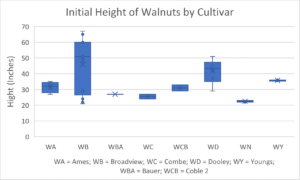
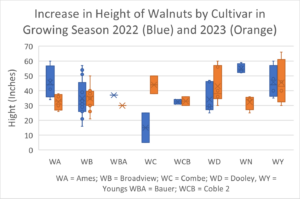
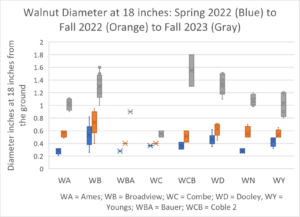
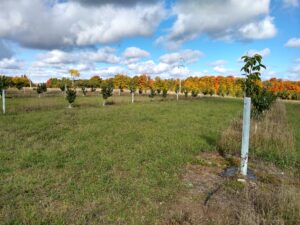
All grafted peaches planted in May 2022 survived until October 2023. Peach initial height as shipped from the nursery in April 2022 was 40 inches. During the 2022 growing season, new terminal growth on the grafted wood averaged 20 to 30 inches. During the 2023 growing season, new terminal growth was even more vigorous at 35 to 45 inches. The diameter of the trunk of the peaches as measured 18 inches off the ground also increased from about 0.5 inches at planting (April 2022) to roughly 2 inches in diameter by October 2023. Like the walnuts, peach growth was impressive and tree quality high. Most of the peaches planted during April 2022, flowered during spring 2023 and produced trace amounts of peaches during August 2023.
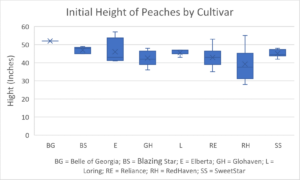
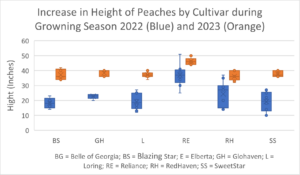
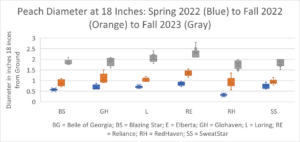
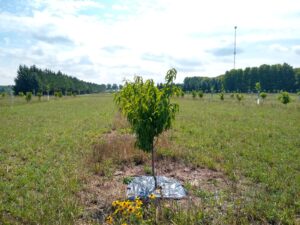
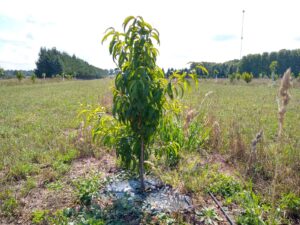
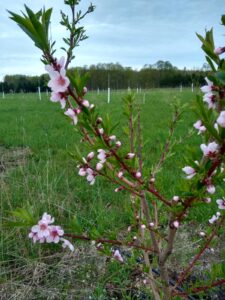
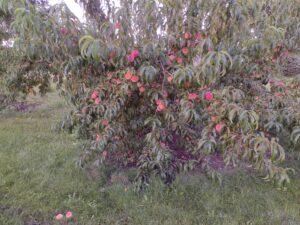
By intercropping the peaches with English walnut, 1 acre of land was saved relative to if the same number of peaches would have been planted in there own stand alone orchard.
Forage Yields in 2022
2,660lbs of forage was harvested from the orchard in 2022. 30 bails of hay (small square, 50 lbs each) were harvested during first cutting in the 1.25 acre orchard. 16 ewes and 30 lambs were rationally grazed through the orchard for 2nd and 3rd cuttings consuming an estimated 1160lbs of forage. 16 ewes consuming 3.5lbs dry equivalent each per day and 30 lambs consuming 2lbs dry equivalent per day = 116lbs per day x 10 grazing days = 1160lbs of forage from grazing.
Forage consumption estimated based on PennState Extension Feeding guidelines.
NRCS conducted monthly clipping of the intercropped/pasture area in 2021 and the results from their survey indicated a yield of 2800lbs per acre. Clipping data was unavailable for 2022 at the time of this report.
Forage Yields in 2023
1,975lbs of forage was harvested from the orchard in 2023. Early season drought conditions caused low yield for first cutting. 10 bails of hay (small square, 50lbs each) were harvested during first cutting. The intercropped orchard area was then grazed with 25 ewes and 30 lambs in July and October. Assuming each ewe consumes 3.5lbs dry equivalent per day (25 ewes) and lambs 2lbs dry equivalent per day (30 lambs) = 147.5lbs forage per day x 10 grazing days = 1475lbs of forage from grazing.
Soil Health
Significant changes in soils were observed between April 2022 and October 2023 in the intercropped/pastured orchard. Significant increases were observed in soil pH, organic matter, potassium, zinc, calcium, magnesium, boron, and the potassium, calcium, magnesium, and sodium components of the cation exchange capacity (CEC). Significant decreases were observed in nitrate, sulfate, iron, manganese, sodium, and the hydrogen component of the CEC (likely because pH increased). Soil testing in future years will be important for understanding the longer term consequences of the pastured intercropping on our soils.
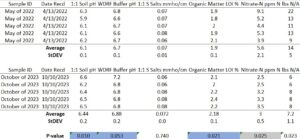

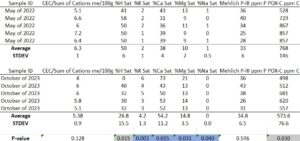
Educational & Outreach Activities
Participation Summary:
In 2022 & 2023, the primary means of communicating project progress was through our Website and Blog which reaches 100's of people (www.oxheights.com).
In 2023, A presentation summarizing our intercropping system was presented to the Annual Meeting of the Midwest Chestnut Producers Council (60+ people attending).
A field day highlighting the Peach/Walnut/Sheep intercropping system was also held on the farm on October 5th along with Presque Isle Conservation District, 15 people participated.
Intercropping at Ox Heights was discussed during a interview with United Chestnuts https://www.youtube.com/watch?v=VFahvK0t77Y and has been viewed 96 times as of January 2024.
After our final report is approved, we will disseminate our results to the New York and Michigan Nut Growers Associations and the Savanna Institute.
Learning Outcomes
We learned intercropping peaches, English walnuts, and forage is relatively easy and efficient. We encountered no issues with the orchard design and no unexpected consequences with sheep pasturing in the orchard. We also learned that English walnut and peaches grow very well on our soils. Fruit and nut production will be important metrics to document and report out on over the next 5 to 10 years. In simple terms, years to production seem very short for peaches and we already have local business lined up to sell our fresh peaches. We were also very encouraged to see significant improvements in our soils over two growing seasons and are excited to continue to document improvements to our soils in over the next 10 years. Overall, we were very happy with this experiment and plan to expand the planting during 2024.
